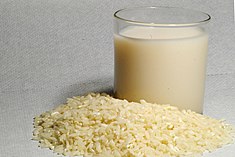Rice milk
 | |
| Nutritional value per 100 g (3.5 oz) | |
|---|---|
| Energy | 195 kJ (47 kcal) |
9.2 g | |
| Sugars | 5.3 g |
| Dietary fiber | 0.3 g |
1.0 g | |
0.3 g | |
Niacin (B3) | 3% 0.4 mg |
| Pantothenic acid (B5) | 3% 0.15 mg |
| Vitamin B6 | 2% 0.04 mg |
| Folate (B9) | 1% 2 μg |
| Vitamin B12 | 26% 0.63 μg |
| Vitamin C | 0% 0 mg |
| Vitamin D | 5% 1 μg |
| Vitamin E | 3% 0.47 mg |
| Vitamin K | 0% 0.2 μg |
Copper | 4% 0.04 mg |
| Iron | 1% 0.2 mg |
| Magnesium | 3% 11 mg |
| Manganese | 12% 0.28 mg |
| Phosphorus | 4% 56 mg |
| Potassium | 1% 27 mg |
| Sodium | 2% 39 mg |
| Zinc | 1% 0.13 mg |
| Other constituents | Quantity |
| Water | 89.3 g |
| †Percentages estimated using US recommendations for adults,[1] except for potassium, which is estimated based on expert recommendation from the National Academies.[2] | |
Rice milk is a plant milk made from rice. Commercial rice milk is typically manufactured using brown rice and brown rice syrup, and may be sweetened using sugar or sugar substitutes, and flavored by common ingredients, such as vanilla.[3] It is commonly fortified with protein and micronutrients, such as vitamin B12, calcium, iron, or vitamin D.[3][4]
History
The exact origin of rice milk is uncertain. In 1914, Maria M. Gilbert gave a recipe for rice milk in her book Meatless Cookery, which was the earliest known use of the term.[5] In 1921, the first rice milk factory was built by the Vita Rice Products Co., launching Vita Rice Milk the same year in San Francisco, California.[6] In 1990, Rice Dream was launched by Imagine Foods of Palo Alto, California in Tetra Pak cartons, becoming the first widely popular rice milk.[7]
Nutrition
Rice milk (unsweetened) is 89% water, 9%
Safety in young children
Because of arsenic levels in rice, the United Kingdom's Food Standards Agency recommends that rice milk should not be given to children under 5 as a replacement for breast milk, formula milk or cow's milk.[8]
Comparison to dairy milk
Rice milk contains more
Rice milk may be consumed by people who are
Commercial brands
Commercial brands of rice milk are available in various flavors, such as vanilla, as well as unflavored, and can be used in many recipes as an alternative to traditional cow milk.[3]
Preparation
Rice milk is made commercially by pressing the rice through a grinding mill, followed by filtration and blending in water.[4][13] It may be made at home using rice flour and brown rice protein, or by boiling brown rice with a large volume of water, blending and filtering the mixture.[4]
Environmental concerns
Rice milk production uses less water than dairy milk and almond milk, but considerably more than soy milk or oat milk.[12]
Gallery
-
A cup of amazake
See also
- List of rice beverages
- Mishti doi
References
- ^ United States Food and Drug Administration (2024). "Daily Value on the Nutrition and Supplement Facts Labels". Retrieved 2024-03-28.
- )
- ^ a b c d e f Meagan Bridges (1 January 2018). "Moo-ove over, cow's milk: The rise of plant-based dairy alternatives" (PDF). Practical Gastroenterology, University of Virginia Medical School. Retrieved 30 January 2020.
- ISBN 9781928914587.
- ISBN 9781928914587.
- ISBN 9781928914587.
- ^ "Arsenic in rice". Food Standards Agency. 18 September 2018.
- ^ a b "Beverages, rice milk, unsweetened", United States Department of Agriculture, Agricultural Research Service.
- ^ "Milk, whole, 3.25% milkfat, with added vitamin D", United States Department of Agriculture, Agricultural Research Service.
- PMID 18835944.
- ^ a b c Guibourg, Clara; Briggs, Helen (2019-02-22). "Which vegan milks are best for the planet?". BBC News: Science and Environment. Retrieved 2019-09-04.
- ^ Courtney Subramanian (26 February 2014). "Milk-off! The real skinny on soy, almond, and rice". Time. Retrieved 30 January 2020.
- ^ a b Annette McGivney (29 January 2020). "Almonds are out. Dairy is a disaster. So what milk should we drink?". The Guardian. Retrieved 30 January 2020.
- ^ PMID 29853680.
External links
- Dairy-Free Diets at Curlie


